【高血压英文PPT精品课件】 Progressive Chronic Kidney Disease_
合集下载
--高血压英文PPT精品课件_5
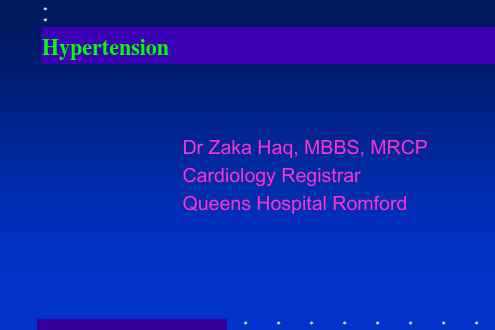
Hypertension is often symptom less, so screening is vital - before damage is done. Many surveys continue to show that hypertension remains under diagnosed, undertreated and poorly controlled in the UK
Approximately 25% are due to Reno vascular disease - most frequently atheromatous (e.g. elderly cigarette smokers with peripheral vascular disease) or fibromuscular dysplasia (more common in younger females). Endocrine disease
Secondary hypertension 5% Underlying cause
Causes of Secondary Hypertension
Renal disease
Approximately 75% are from intrinsic renal disease: glomerulonephritis, polyarteritis nodosa, systemic sclerosis, chronic pyelonephritis, or polycystic kidneys.
Hypertension, Introduction.
Hypertension is one of the most important preventable causes of premature morbidity and mortality in the UK. Hypertension is a major risk factor for stroke (ischemic and haemorrhagic), myocardial infarction, heart failure, chronic kidney disease, cognitive decline and premature death. Untreated hypertension may result in vascular and renal damage that can culminate in a treatment-resistant state.
Approximately 25% are due to Reno vascular disease - most frequently atheromatous (e.g. elderly cigarette smokers with peripheral vascular disease) or fibromuscular dysplasia (more common in younger females). Endocrine disease
Secondary hypertension 5% Underlying cause
Causes of Secondary Hypertension
Renal disease
Approximately 75% are from intrinsic renal disease: glomerulonephritis, polyarteritis nodosa, systemic sclerosis, chronic pyelonephritis, or polycystic kidneys.
Hypertension, Introduction.
Hypertension is one of the most important preventable causes of premature morbidity and mortality in the UK. Hypertension is a major risk factor for stroke (ischemic and haemorrhagic), myocardial infarction, heart failure, chronic kidney disease, cognitive decline and premature death. Untreated hypertension may result in vascular and renal damage that can culminate in a treatment-resistant state.
高血压英文PPT精品课件ChronicKidneyDiseaseintheUnited
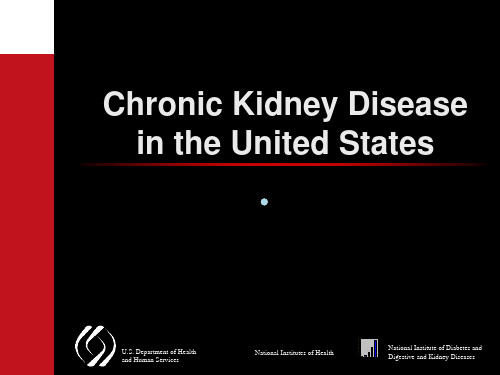
African Americans
3.8 X
Native Americans
2.0 X
Asians/Pacific Islander
1.3 X
The relative risk of Hispanics compared to non-Hispanics is about 1.5 X
USRDS, 2004
Costs of Kidney Failure are High
(in $billions for 2002)
Kidney Failure
Care
25.2
Total NIH Budget
Kidney Failure Accounts for 6% of Medicare Payments
23.2
Lost Income for Patients is $2-4 Billion/Yr
USRDS, 2004
CKD Predicts CVD
Age-Standardized Rate of Cardiovascular Events (per 100 person-yr)
No Image
Estimated GFR (mL/min/1.73 m2)
Go, et al., 2004
Treatment to Prevent Progression of CKD to Kidney Failure
Coresh, et al., 2005
Incident Counts & Adjusted Rates, By Primary Diagnosis
USRDS, 2004
Incidence of Kidney Failure
(per million population, 1990, by HSA, unadjusted)
高血压(英文版) ppt课件

Hypertension
Introduction
Hypertension is a major public health problem throughout the world because of its high prevalence and its association with increased risk of cardiovascular disease.
<90
130140-159 140-149
Epidemiology
Prevalence rate ( 患 病 率 ) China: In 1959, In 1979, 5.11% 7.73% of hypertension in
In 1991,
11.88%
The prevalence of high BP increases with age. Hypertension is more common in men than in women up to age 50, after that age, hypertension is more common in women. Hypertension is more common in northern China than in southern China.
For instance:
21/3 1st visit: 146/98mmHg, 150/98mmHg 23/3 2nd visit: 128/84, 126/80
27/3 3rd visit: 130/80, 130/82
Notes(continue)
4. Optimal BP with respect to cardiovascular risk is less than 120/80 mmHg. However, unusually low readings should be evaluated for clinical significance. For example, 70/50 mmHg is less than 120/80 mmHg, but it is not optimal.
Introduction
Hypertension is a major public health problem throughout the world because of its high prevalence and its association with increased risk of cardiovascular disease.
<90
130140-159 140-149
Epidemiology
Prevalence rate ( 患 病 率 ) China: In 1959, In 1979, 5.11% 7.73% of hypertension in
In 1991,
11.88%
The prevalence of high BP increases with age. Hypertension is more common in men than in women up to age 50, after that age, hypertension is more common in women. Hypertension is more common in northern China than in southern China.
For instance:
21/3 1st visit: 146/98mmHg, 150/98mmHg 23/3 2nd visit: 128/84, 126/80
27/3 3rd visit: 130/80, 130/82
Notes(continue)
4. Optimal BP with respect to cardiovascular risk is less than 120/80 mmHg. However, unusually low readings should be evaluated for clinical significance. For example, 70/50 mmHg is less than 120/80 mmHg, but it is not optimal.
高血压英文PPT精品课件ChronicDisease

216.6
145.4 HP 2010 Goal: 159.9 105.7
Black
Hispanic
Race/Ethnicity
Asian/Other
Note: All rates are adjusted to 2000 Standard U.S. Population. Source: California Death Statistical Master File; SANDAG January 1, Population Estimates.
Nutrition by Gender
Women
Healthcare Cost in California and San Diego
• $130 Billion spent (treatment and lost productivity) by California in 2003
• $4.3 Billion in SD County (not including
Year San Diego
*2006 U.S. data are preliminary
2004 U.S.
2005
2006*
San Diego County Population
by Race/Ethnicity, 2007
• 3 million people
• Racial/Ethnic groups from around the world.
What Is Chronic Disease?
• According the U.S. National Center for Health Statistics, is a disease that lasts 3 months or more.
高血压英文PPT精品课件Cerebrovascular

deficit that has a sudden onset, lasts more than 24 hours, and results from cerebrovascular disease.
A stroke occurs when there is a disruption
of blood flow to a region of the brain.
Dysphasia: difficulty in speaking and putting words into the correTATIONS
A stroke is usually characterized by the sudden onset of focal neurological impairment.
About one-fourth of strokes are hemorrhagic, resulting from hypertensive vascular disease (which causes an intracerebral hemorrhage), a ruptured aneurysm, or an arteriovenous malformation.
Risk factors for stroke include smoking, hypertension, obesity, cardiac disease, hypercholesterolemia, diabetes, and use of birth control pills.
Prevention efforts focus on lifestyle changes that can modify risk factors.
PATHOPHYSIOLOGY
A stroke occurs when there is a disruption
of blood flow to a region of the brain.
Dysphasia: difficulty in speaking and putting words into the correTATIONS
A stroke is usually characterized by the sudden onset of focal neurological impairment.
About one-fourth of strokes are hemorrhagic, resulting from hypertensive vascular disease (which causes an intracerebral hemorrhage), a ruptured aneurysm, or an arteriovenous malformation.
Risk factors for stroke include smoking, hypertension, obesity, cardiac disease, hypercholesterolemia, diabetes, and use of birth control pills.
Prevention efforts focus on lifestyle changes that can modify risk factors.
PATHOPHYSIOLOGY
高血压 英语PPT课件

• "Blood pressure" is the force of blood pushing against the walls of the arteries as the heart pumps blood. If this pressure rises and stays high over time, it can damage the body in many ways.
9
Signs and Symptoms of High
Blood Pressure
• High blood pressure (HBP) itself usually has no signs or symptoms. Rarely, headaches may occur.
• Some people only learn that they have HBP after the damage has caused problems, such as coronary hear disease, stroke, or kidney failure.
7
• For some women, blood pressure can rise if they use birth control pills, become pregnant, or take hormone therapy.
• Children younger than 10 years old who have HBP often have another condition that's causing it (such as kidney disease).
8
• An inherited genetic factors: about half of patients have family history of hypertension
9
Signs and Symptoms of High
Blood Pressure
• High blood pressure (HBP) itself usually has no signs or symptoms. Rarely, headaches may occur.
• Some people only learn that they have HBP after the damage has caused problems, such as coronary hear disease, stroke, or kidney failure.
7
• For some women, blood pressure can rise if they use birth control pills, become pregnant, or take hormone therapy.
• Children younger than 10 years old who have HBP often have another condition that's causing it (such as kidney disease).
8
• An inherited genetic factors: about half of patients have family history of hypertension
《高血压英语》课件

了解高血压可能导致的一些严重健康问题,如心脏病、中风和肾脏问题。
预防与治疗
饮食
了解如何通过健康的饮食来预防和管理高血压。
减肥
了解如何通过控制体重来降低高血压的风险。
运动
探索适合高血压患者的运动方式,以维持健康。
药物治疗
介绍高血压的常用药物和治疗选项。
与高血压相关的英语词汇
1 血压
了解血压的定义和测量方 式。
2 心脏
探索心脏的结构和功能, 以及它与高血压之间的关 系。
ห้องสมุดไป่ตู้
3 动脉
了解动脉的作用和与高血 压的相关性。
4 血管
了解血管的结构和功能,以及其在高血压中 的角色。
5 测量血压的工具
介绍用于测量血压的不同工具和设备。
医生的面诊
了解在与医生交流时使用的常见英语表达,如病症描述和治疗方案。
处理心理问题
1
《高血压英语》PPT课件
# 高血压英语PPT课件 探索高血压的定义,症状和风险。了解如何预防和治疗高血压以及相关的英 语词汇。
什么是高血压?
高血压是一种常见的健康问题,也称为高血压。了解什么是高血压以及它对 身体的影响。
高血压的症状
探索高血压可能引起的一些常见症状,如头痛、头晕和呼吸困难。
高血压的风险
被诊断出患有高血压的心理反应
了解当你被诊断出患有高血压时可能出现的心理反应。
2
减轻心理负担的方法
探索如何通过积极的心理策略来减轻与高血压相关的心理负担。
3
支持小组
介绍参加支持小组的好处,并了解如何加入。
总结
高血压的关键知识点
简要回顾高血压的关键知识点, 以加强理解。
处理高血压的英语技能
预防与治疗
饮食
了解如何通过健康的饮食来预防和管理高血压。
减肥
了解如何通过控制体重来降低高血压的风险。
运动
探索适合高血压患者的运动方式,以维持健康。
药物治疗
介绍高血压的常用药物和治疗选项。
与高血压相关的英语词汇
1 血压
了解血压的定义和测量方 式。
2 心脏
探索心脏的结构和功能, 以及它与高血压之间的关 系。
ห้องสมุดไป่ตู้
3 动脉
了解动脉的作用和与高血 压的相关性。
4 血管
了解血管的结构和功能,以及其在高血压中 的角色。
5 测量血压的工具
介绍用于测量血压的不同工具和设备。
医生的面诊
了解在与医生交流时使用的常见英语表达,如病症描述和治疗方案。
处理心理问题
1
《高血压英语》PPT课件
# 高血压英语PPT课件 探索高血压的定义,症状和风险。了解如何预防和治疗高血压以及相关的英 语词汇。
什么是高血压?
高血压是一种常见的健康问题,也称为高血压。了解什么是高血压以及它对 身体的影响。
高血压的症状
探索高血压可能引起的一些常见症状,如头痛、头晕和呼吸困难。
高血压的风险
被诊断出患有高血压的心理反应
了解当你被诊断出患有高血压时可能出现的心理反应。
2
减轻心理负担的方法
探索如何通过积极的心理策略来减轻与高血压相关的心理负担。
3
支持小组
介绍参加支持小组的好处,并了解如何加入。
总结
高血压的关键知识点
简要回顾高血压的关键知识点, 以加强理解。
处理高血压的英语技能
高血压英文PPT精品课件HYPERTENSIONANDVASCULAR
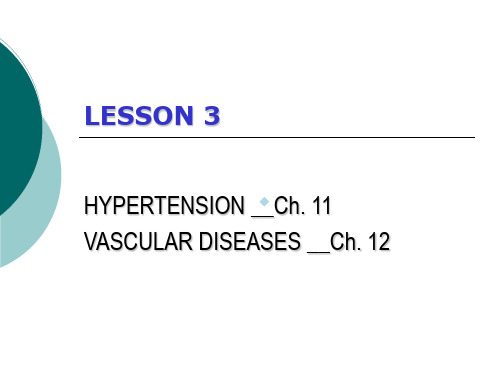
Moderation of alcohol consumption
Hale Waihona Puke Limit consumption to no more than 2 drinks (1 oz or 30 mL ethanol; eg, 24 2–4 mm Hg oz beer, 10 oz wine, or 3 oz 80-proof whiskey) per day in most men and to no more than 1 drink per day in women and lighter-weight persons.
(elevated serum creatinine,
▪(2) Renovascular disease
abnormal urinalysis),
(abdominal bruits)
▪(3) APKD-autosomal dominant
polycystic kidney disease (abdominal or flank masses)
Prehypertension:
recheck in 1 year
2. Stage 1 hypertension: SBP 140–159 or DBP 90–99
Stage 1 hypertension:
confirm within 2 months
2 separate office visits)
▪(5) Primary hyperaldosteronism
(hypokalemia)
7
JNC VII 2003 recommendations
Normal: recheck in 2 years (see Comments)
高血压(英文版) ppt课件

Etiology and pathogenesis of EH
No
cause can be established Possible mechanisms Genetic tendency
Spontaneous hypertension rat EH tends to cluster in families
Classification of Blood Pressure Levels (mmHg)
Category Systolic Diastolic Hypotension??? <60 Optimal <120 <80 Normal <130 <85 High-normal 139 85-89 Grade 1 hypertension(mild) 90-99 Subgroup: borderline 90-94
Optional investigations
Plasma renin( 肾 素 ) activity & aldosterone (醛固酮), urinary VMA(香草杏仁酸),to identify secondary hypertension Echocardiography, to detect ventricular hypertrophy Vascular ultrasonography should be performed if arterial disease is suspected. Renal ultrasonography should be performed if renal disease is suspected.
perhaps by catecholamines儿茶酚胺
高血压英文PPT精品课件WORLDKIDNEY

What Can WKD Do (2)?
2. Advocate i. With National, State and Local Governments for Better Kidney Disease: - Education - Prevention - Detection - Treatment ii. With Other Major Organizations; e.g., Insurance Agencies, Large Health Care Providers, Universities, etc.
Kelley et al, In1-1437
Challenges of CKD
Management problems, enormous everywhere, are particularly great, even overwhelming, in developing countries: 1. Little awareness of CKD or its consequences 2. Few financial resources for prevention, detection or treatment 3. Little expertise 4. High prevalence of CKD
Annual CVD Mortality (%)
10
1 0.1 0.01 0.001
25-34 35-44 45-54 55-64 66-74 75-84
Age (years)
GP Male GP Female GP Black GP White Dialysis Male Dialysis Female Dialysis Black Dialysis White
高血压英语PPTPPT课件

Blood pressure readings of 180/110 mmHg or higher
Headache
Vision changes
Shortness of Breath
Fatigue
Dizziness
Chest pain or discomfort
01
02
03
04
05
06
Symptoms of Hypertension
Mental stress
Sleep quality
Chronic stress
03
The HAZARDS of Hypertension
Increased risk of heart disease
High blood pressure can damage the heart muscle, leading to heart disease
Hypertension English PPT courseware
contents
目录
Introduction to Hypertension The causes of hypertension The HAZARDS of Hypertension Diagnosis and prevention of hypertension
Diagnostic method
ቤተ መጻሕፍቲ ባይዱ
Preventive measure
Healthy die: A balanced die rich in fruits, vegetables, whole grains, and lean protein can help reduce blood pressure Limiting salt and reducing intake of saturated fat and trans fat are also important
Headache
Vision changes
Shortness of Breath
Fatigue
Dizziness
Chest pain or discomfort
01
02
03
04
05
06
Symptoms of Hypertension
Mental stress
Sleep quality
Chronic stress
03
The HAZARDS of Hypertension
Increased risk of heart disease
High blood pressure can damage the heart muscle, leading to heart disease
Hypertension English PPT courseware
contents
目录
Introduction to Hypertension The causes of hypertension The HAZARDS of Hypertension Diagnosis and prevention of hypertension
Diagnostic method
ቤተ መጻሕፍቲ ባይዱ
Preventive measure
Healthy die: A balanced die rich in fruits, vegetables, whole grains, and lean protein can help reduce blood pressure Limiting salt and reducing intake of saturated fat and trans fat are also important
高血压英文PPT精品课件Diseasesofthe
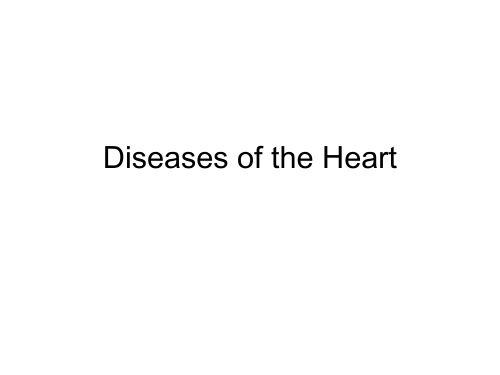
• CAD • Almost all from atherosclerotic narrowing
or complete obstruction • Depending on the degree & character of
the obstruction
– angina pectoris – MI – sudden cardiac death – chronic ischemic heart disease with CHF
Diseases of the Heart
Major Determinants of Disease
• Most heart disease is the result of atherosclerotic obstruction of the coronary arteries
• Congestive heart failure is mechanical failure of the heart to eject blood delivered to it
• Premature ventricular contractions
– occur in healthy people – chest palpitations & anxiety
• Ventricular tachycardia
– spontaneous, regular beating at > 120 beats/min
• Each year heart disease accounts for about 1/3 of deaths in the US, most of which are associated with coronary artery atherosclerosis. If cerebrovascular disease, vascular complications of diabetes, & other vascular diseases are included, the figure is over 40%. After age 40 the lifetime risk for developing symptomatic coronary artery disease is 50% in men & 40% in women.
or complete obstruction • Depending on the degree & character of
the obstruction
– angina pectoris – MI – sudden cardiac death – chronic ischemic heart disease with CHF
Diseases of the Heart
Major Determinants of Disease
• Most heart disease is the result of atherosclerotic obstruction of the coronary arteries
• Congestive heart failure is mechanical failure of the heart to eject blood delivered to it
• Premature ventricular contractions
– occur in healthy people – chest palpitations & anxiety
• Ventricular tachycardia
– spontaneous, regular beating at > 120 beats/min
• Each year heart disease accounts for about 1/3 of deaths in the US, most of which are associated with coronary artery atherosclerosis. If cerebrovascular disease, vascular complications of diabetes, & other vascular diseases are included, the figure is over 40%. After age 40 the lifetime risk for developing symptomatic coronary artery disease is 50% in men & 40% in women.
--高血压英文PPT精品课件Chronic Renal

2000年全国血透病人原发病构成Βιβλιοθήκη 22%11% 60%
7% CGN HTN DN 其他
注:2000年全国血透病人原发病资料缺少中南、山东、北京、东北资料
2002年年底上海市尚存3416例 慢性肾功能衰竭血透患者主要原发病因
2000
1500
1502
44.47%
1000 500
The progression of CRF leads, in the majority of instances, to end stage renal disease (ESRD) at which point renal replacement therapy is required.
▪ The rate of progression of CRF
Definition(定义)
✓ CRF is a permanent, usually progressive, diminution in renal function to a degree that has damaging consequences for the patient.
✓ It is characterized by an increasing inability of the kidney(肾脏) to maintain normal low levels of the products of protein metabolism(such as urea), normal blood pressure and hematocrit, and sodium, water, potassium, and acid-base(酸碱) balance.
CAUSES OF CHRONIC RENAL FAILURE (2)
高血压英文PPT精品课件_3
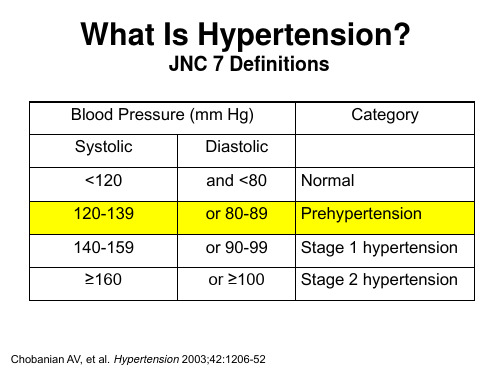
BPLTTC Meta-analysis: Stroke and CHD
Relative Risk of Stroke Relative Risk of CHD
Stroke
1.50
CHD
1.50
1.25
1.25
1.00
1.00
0.75
0.75
0.50
0.50
0.25
0.25
-10 -8 -6 -4 -2 0 2 4
2 mm Hg decrease in mean SBP
7% reduction in risk of CHD mortality
10% reduction in risk of stroke mortality
Prospective Studies Collaboration. Lancet. 2002;360:1903-1913.
No Compelling Indications
Stage 1 140-159/90-99 Diuretics for most;
consider ACEI, ARB, B, CCB
Stage 2 BP 160/100 2-drug combo for
most (diuretic + ACEI, or ARB, or BB, or CCB)
What Is Hypertension?
JNC 7 Definitions
Blood Pressure (mm Hg)
Systolic
Diastolic
<120
and <80
120-139
or 80-89
140-159
or 90-99
≥160
高血压危象(英文版) PPT

Secondary causes of resistant hypertension
Medication that can interfere with blood pressure control
Conditions favouring use of some antihypertensive drugs versus others
Definitions and classification of blood pressure levels (mmHg)
Factors influencing prognosis
Factors influencing prognosis
大家学习辛苦了,还是要坚持
继续保持安静
High/Very high risk subjects
“malignant HPT”
– describe those individuals with group 4 KWB retinopathy changes + papilledema
Definitions
Hypertensive Crisis
Hypertensive Emergency………1-2 hours
Cerebrovascular Hypertensive Emergencies
Cerebral Infarct Intracerebral Hemorrhage Cerebral Edema
Hypertensive Encephalopathy
Cerebral blood flow a function of CPP
Hypertensive encephalopathy Intracerebral bleed Acute MI Acute CHF with pulm edema Unstable angina Aortic dissection Eclampsia
- 1、下载文档前请自行甄别文档内容的完整性,平台不提供额外的编辑、内容补充、找答案等附加服务。
- 2、"仅部分预览"的文档,不可在线预览部分如存在完整性等问题,可反馈申请退款(可完整预览的文档不适用该条件!)。
- 3、如文档侵犯您的权益,请联系客服反馈,我们会尽快为您处理(人工客服工作时间:9:00-18:30)。
• CKD was defined by presence of blood or protein on urinalysis and/or serum creatinine >150
• 8% of the surveyed group had diabetes and half of them were unaware of Dx
• Indigenous populations have much higher rates of end stage kidney disease (ESKD)
• Risk factors for ESKD
– Hypertension – Diabetes – Family history – Ethnicity – Smoking – Obesity
– About 1 in 20 people have abnormalities on urinalysis
– About 8% of the general population have evidence of diabetes mellitus
– About 1 in 10 type 2 diabetics have evidence of diabetic nephropathy
• Further discussion
Take home message
• Single urine dipstick for protein – limitations false positives, false negatives
• Kidney function should be measured at least yearly in those at increased risk CKD
– Those with diabetes are at risk of end stage kidney disease
Case 1 cont.
• Question 1
• In large epidemiological surveys for diabetes and chronic kidney disease, which of the following are correct?
culture
Case 1
• Question 2 • Which of the following is the most
appropriate investigation when screening for CKD?
– 24 hr urinary protein – 24 hr urinary albumin excretion – Urinary prot/creat ratio on a spot urine – Urinary alb/creat ratio on a spot urine – MSU with dipstick, spot ACR, microscopy
and culture
Discussion
• CARI/KCAT reviewed evidence • Combo screening the best –
– U/A – MSU - m,c,s – ACR – BP – Serum creatinine (GFR)
• This should be done Байду номын сангаасearly in high risk groups – eg diabetics, ATSI
– Those with diabetes are at risk of end stage kidney disease
Discussion Case 1
• AusDiab 1 in 7 pts in Australia have diabetes. This can be as high as 1 in 3 in indigenous Australians
• 30% of those surveyed had hypertension with half being unaware of Dx
• 1 in 3 type 2 diabetics will develop nephropathy
Take home message
• Type 2 Diabetes is now worldwide, the most common cause of end stage kidney disease
【高血压英文PPT精品课件】 Progressive Chronic Kidney Disease
Case 1 cont.
• In large epidemiological surveys for diabetes and chronic kidney disease, which of the following are correct?
– About 1 in 20 people have abnormalities on urinalysis
– About 8% of the general population have evidence of diabetes mellitus
– About 1 in 10 type 2 diabetics have evidence of diabetic nephropathy
Case 1
• Question 2 • Which of the following is the most
appropriate investigation when screening for CKD?
– 24 hr urinary protein – 24 hr urinary albumin excretion – Urinary prot/creat ratio on a spot urine – Urinary alb/creat ratio on a spot urine – MSU with dipstick, spot ACR, microscopy and
• 8% of the surveyed group had diabetes and half of them were unaware of Dx
• Indigenous populations have much higher rates of end stage kidney disease (ESKD)
• Risk factors for ESKD
– Hypertension – Diabetes – Family history – Ethnicity – Smoking – Obesity
– About 1 in 20 people have abnormalities on urinalysis
– About 8% of the general population have evidence of diabetes mellitus
– About 1 in 10 type 2 diabetics have evidence of diabetic nephropathy
• Further discussion
Take home message
• Single urine dipstick for protein – limitations false positives, false negatives
• Kidney function should be measured at least yearly in those at increased risk CKD
– Those with diabetes are at risk of end stage kidney disease
Case 1 cont.
• Question 1
• In large epidemiological surveys for diabetes and chronic kidney disease, which of the following are correct?
culture
Case 1
• Question 2 • Which of the following is the most
appropriate investigation when screening for CKD?
– 24 hr urinary protein – 24 hr urinary albumin excretion – Urinary prot/creat ratio on a spot urine – Urinary alb/creat ratio on a spot urine – MSU with dipstick, spot ACR, microscopy
and culture
Discussion
• CARI/KCAT reviewed evidence • Combo screening the best –
– U/A – MSU - m,c,s – ACR – BP – Serum creatinine (GFR)
• This should be done Байду номын сангаасearly in high risk groups – eg diabetics, ATSI
– Those with diabetes are at risk of end stage kidney disease
Discussion Case 1
• AusDiab 1 in 7 pts in Australia have diabetes. This can be as high as 1 in 3 in indigenous Australians
• 30% of those surveyed had hypertension with half being unaware of Dx
• 1 in 3 type 2 diabetics will develop nephropathy
Take home message
• Type 2 Diabetes is now worldwide, the most common cause of end stage kidney disease
【高血压英文PPT精品课件】 Progressive Chronic Kidney Disease
Case 1 cont.
• In large epidemiological surveys for diabetes and chronic kidney disease, which of the following are correct?
– About 1 in 20 people have abnormalities on urinalysis
– About 8% of the general population have evidence of diabetes mellitus
– About 1 in 10 type 2 diabetics have evidence of diabetic nephropathy
Case 1
• Question 2 • Which of the following is the most
appropriate investigation when screening for CKD?
– 24 hr urinary protein – 24 hr urinary albumin excretion – Urinary prot/creat ratio on a spot urine – Urinary alb/creat ratio on a spot urine – MSU with dipstick, spot ACR, microscopy and
